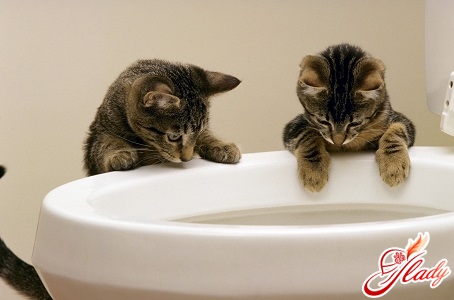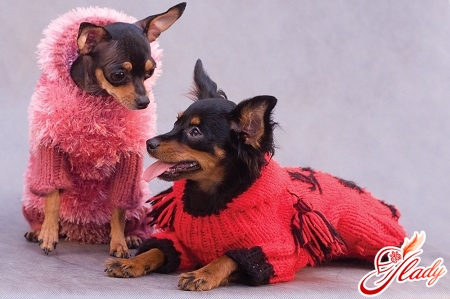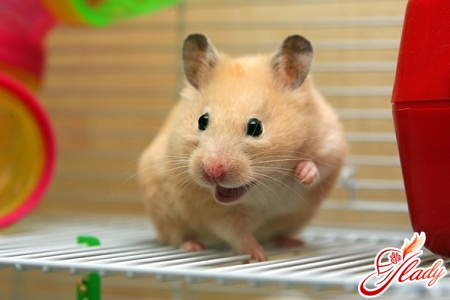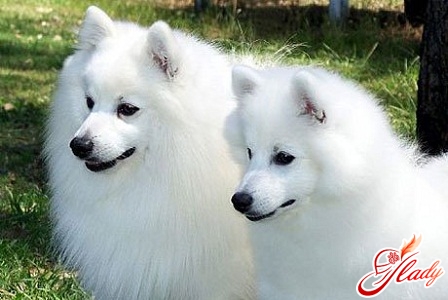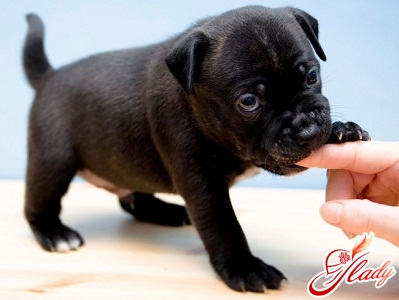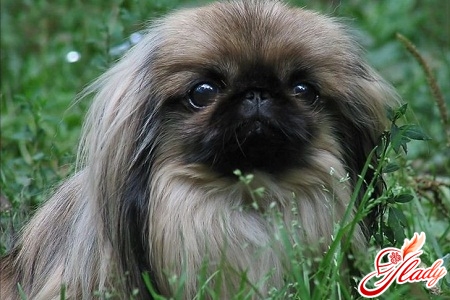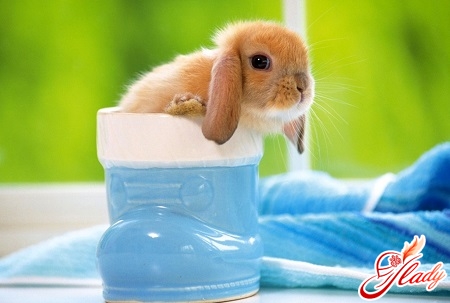 Rabbits are very nice creatures, so theircontent at home will bring you a lot of fun. These decorative animals are very friendly and playful. In addition, the care of a dwarf home rabbit is not so complicated. Walking is not necessary, he is easily accustomed to go to the cat's tray. And rabbits are great pets for children. These funny kids can be taken with them to the dacha or left with friends and acquaintances on holiday, as they do not cause much trouble. But, nevertheless, having decided to start houses of a dwarf rabbit, it is necessary to remember that you acquire not a furry toy, but a living being with its own character and habits, requiring attention, care and affection. From this article you can find out how many live dwarf rabbits, what they eat, what care they need. In addition, we will talk about what diseases are in these animals and what you should know before choosing a pet. So, the first thing that interests future owners of an animal is how to determine the gender of their pet. The sex of the rabbit can be easily determined at the age of 3-4 months. In males at this age, the testicles are clearly visible, and naturally they do not. If you turn the pet upside down with the paws, pulling the tail, then the female can see a slit originating from the anus, and in the male - a small round hole, located 3-4 mm from the anal. From ordinary rabbits dwarfish breed differs in size and weight. Instead of 5-8 kg of "live weight" of their big brothers, our kids do not exceed a mark of 1.6 kg. But to please you with your presence in the house rabbits will be from 6 to 12 years. And this is another reason to take your pet's choice with every possible seriousness, because soon it will become a part of your life.
Rabbits are very nice creatures, so theircontent at home will bring you a lot of fun. These decorative animals are very friendly and playful. In addition, the care of a dwarf home rabbit is not so complicated. Walking is not necessary, he is easily accustomed to go to the cat's tray. And rabbits are great pets for children. These funny kids can be taken with them to the dacha or left with friends and acquaintances on holiday, as they do not cause much trouble. But, nevertheless, having decided to start houses of a dwarf rabbit, it is necessary to remember that you acquire not a furry toy, but a living being with its own character and habits, requiring attention, care and affection. From this article you can find out how many live dwarf rabbits, what they eat, what care they need. In addition, we will talk about what diseases are in these animals and what you should know before choosing a pet. So, the first thing that interests future owners of an animal is how to determine the gender of their pet. The sex of the rabbit can be easily determined at the age of 3-4 months. In males at this age, the testicles are clearly visible, and naturally they do not. If you turn the pet upside down with the paws, pulling the tail, then the female can see a slit originating from the anus, and in the male - a small round hole, located 3-4 mm from the anal. From ordinary rabbits dwarfish breed differs in size and weight. Instead of 5-8 kg of "live weight" of their big brothers, our kids do not exceed a mark of 1.6 kg. But to please you with your presence in the house rabbits will be from 6 to 12 years. And this is another reason to take your pet's choice with every possible seriousness, because soon it will become a part of your life.
Types of dwarf rabbits
Before you go to the store for a pet,you should know which breeds of dwarf rabbits you like the most. They differ not only in appearance, but also in character, so think carefully about what kind of behavior of a pet you like. So, let's look at the types of dwarf rabbits. Dwarf Rabbit Baran Ram - a wonderful lop-eared rabbit. Animals of this breed are slightly larger than their relatives, colored dwarfs. Adult Sheep can reach a weight of 1.8 kg to 2 kg. Thanks to their wonderful ears, these rabbits look very nice, calm and affectionate creatures. And indeed it is. Until the age of two weeks, distinguishing Baran from other breeds is quite problematic, since in this period their ears are standing. They start from the age of three weeks. And by the four weeks in most cases they are already hanging down the sides of the animal's head. And at the top of the ears are connected by a roller-wreath. In other cases, the gradual hanging of the ears can last up to the age of three months, and one can often observe such a funny picture: one ear hangs, and the other still haughtily sticks out. In this case, the Baran looks pretty funny and amusing. The lop-eared baby quickly becomes attached to the owner and, like a dog, follows him wherever he goes. The sheep of the Baran breed can bring 4-8 rabbits, which is pretty much for dwarf rabbits. In general, if you need a rabbit with a sweet character, then the Rabbit Baran is exactly what you need. Dwarf colored rabbits These are small animals with standing ears. The weight of an adult rabbit reaches 0.8-1.5 kg. These babies have several color variations:
- White-fleece;
- Mardera (blue or brownish with a darker muzzle);
- Black-and-fiery;
- Red satin;
- Hotto (white with black circles around the eyes);
- Siamese color;
- White;
- Red, etc.
The most interesting color is the redsateen. In bright light, their red skins literally glow red. Bunnies of this breed bring from 2 to 4 rabbits. The nature of this type of rabbit is very unpredictable. They can be both friendly-compliant and highly aggressive. The peak of aggressiveness of colored rabbits falls on the age of 5-9 months - this is the period of their puberty. Usually, aggressiveness passes by a year and a half or slightly later. To reduce the aggressiveness of rabbits, you should castrate the males. In addition, if you want to grow a friendly pet, then from a young age give him more affection. Rabbits like rabbits especially when they scratch their cheeks and forehead between the ears. If you need a cheerful, active rabbit, then a colored dwarf breed is the best option. Fox dwarf rabbits Fox rabbits belong to longhaired breeds. The weight of an adult varies from 0.8 kg to 1.5 kg. Bunnies bring in 2 to 6 cubs. Throughout the body Foxbirds have long wool, but on the head - short and smooth. The length of the hair on the body of such ears can reach 7 cm, and sometimes even more. Rabbits of this breed can have the following colors:
- chinchilla;
- redhead;
- agouti;
- blue;
- white;
- white-spotted.
The character of Fox rabbits, as well as colored rabbits,unpredictable. The skin of the pet requires constant care. If you like animals with long hair and you agree to comb their fur at least once a week, then Lisy the rabbit is your option. Angora dwarf rabbits These animals have a thick long fur around the body, including on the ears and on the muzzle. But unlike the Fox rabbits, whose wool is awn, Angora rabbits are downy. The hairs of the wool are very thin and soft, reaching a length of 20 cm. The rabbits bring 2-6 rabbits. The weight of an adult dwarfish Angora rabbit varies from 1 to 1.6 kg. Its appearance is very exotic. Many people in appearance compare these cute puppies with small dogs. The nature of rabbits is different - both aggressive and extremely friendly. If you want all friends and surrounding people to get excited about the appearance of your pet, then buy an Angora dwarf rabbit, do not go wrong. Dwarf rabbits Rex You will be amazed at the refinement of Rex's dwarf rabbits. The wool of these lovely creatures is short and velvety, so they are of the type of short-haired animals. Reks are of the following colors:
- Castor Rex (brown);
- Black;
- Bright reddish;
- White;
- Light with spots.
Dwarf rabbits of the breed Rex are very elegant, theirthe appearance is somewhat unusual. These pets have a light, rather narrow head with very long ears. The weight of adults is rarely more than 1.6 kg. At an early age these babies are very ugly. At the sight of the rabbit-Rex, it never comes to my mind that from this awful creature with an incomprehensible look of wool one day, an elegant handsome man will grow up. The nature of such rabbits is very balanced, calm. All the movements of the adult Rex are graceful, in connection with which it can be compared with a fairy deer. Dwarf rabbits of Germelin breed Rabbits of Germelin breed possess only white color. The eyes of these amazing creatures are either red or blue. By the ratio to the body, the Germelins have a very large head. The wool of rabbits is short and dense. The weight of adults varies from 1 to 1.5 kg. The females and males are different in nature. Males are calm, often lazy and unperturbed animals. But females are often aggressive. Therefore, if you buy a pet for a child, it is best to acquire exactly the males. Japanese dwarf rabbit Very beautiful and unusual coloring of the Japanese dwarf rabbit. Throughout the body of the animal are located dark and yellow stripes, with one side of the baby dark, and the other - a yellowish hue. The border of flowers passes through the center of the back, along the spine. Particularly attractive are those individuals whose coloring changes in a checkerboard pattern. Dwarf Dutch rabbit One of the most popular breeds are dwarf Dutch dwarf rabbits. This breed was bred in the 1950s and 60s in Holland by the famous rabbit breeder Andrian de Kock. The rabbit's body is short and strong, the neck is almost absent, the chest is wide. The paws of the animal are very strong and short, and the head is wide, well developed. Dutch rabbits, like the breed of Baran, lop-eared. Animals are of the following colors:
- Motley;
- Madagascar;
- Lilac;
- Light gray;
- Slight gray;
- Dull gray;
- Isabel;
- Colors of the marten.
By nature, these rabbits are very nice and friendly. The weight of an adult pet varies from 1.2 to 1.6 kg. The area around the eyes, the ears and the back of the rabbit's body are colored, but the rest of the body is white. In addition, the baby's hind legs are also white, so it seems that the rabbit is wearing socks. 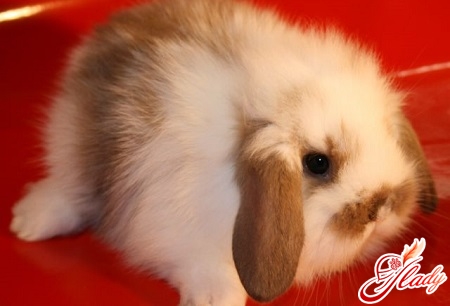
Care for dwarf rabbits
Caring for dwarf rabbits perfectlynot burdensome. The only exception is the longhaired breed. By themselves, these animals are extremely clean, most of the time they devote to caring for fur. In rabbits living in warm apartments, the moulting period lasts a little longer than for those who live in the open air. During moult, animals should be combed more often with a special brush. In the rest of the time, short-haired babies can be combed at will, but for a fur coat of a long-haired rabbit, daily care is required, otherwise the fur can fall. Then you can not do without scissors and cutting out the katysh. Among other things, rabbits should cut their claws, for which the usual manicure scissors are also suitable. If the pet has light claws, then the blood vessels in the base are clearly visible on them. Cut must be so as not to accidentally damage them. But with the claws of dark rabbits should be treated more cautiously, so as not to damage this site. As you can see, rabbits of dwarf species are not particularly affected by problems, and caring for them is extremely simple. Therefore, to puzzle over how to keep these dear pets, it is not necessary. Sometimes it is enough to wash, comb and cut their claws. Well, of course, properly fed! And what do dwarf rabbits eat? The food for these animals must be varied. In the summer-autumn period, when there is a lot of juicy greens, you should give more grass and add a little concentrates. An excellent food for dwarf rabbits in the summer are dandelions, wormwood, plantains, field sow, yarrow, burdock, willow-tea, tansy, mouse peas, clover and a number of wild herbs. These herbs are very juicy, the animals eagerly eat them. But it should be remembered that it is necessary to give these herbs in the mixture or alternate them. Plants such as vetch, alfalfa and peas should be introduced into the pet's diet gradually, better in combination with cereals. Do not feed rabbits with the same grass. Before giving the animal watermelon, silage, carrots or beets, reduce the amount of drinking, because these products are very rich in water, and with excessive amounts of fluid in rabbits, indigestion may occur. What else do dwarf rabbits eat? They really like wood feed, and in particular - fresh thin branches of aspen, lime, willow, acacia, apple. And in the winter time, rabbits are happy to eat pine needles, spruce and juniper. But it should be remembered that low-fiber foods and high amounts of sugar can provoke a stasis of the digestive system, which often leads to the death of the animal. In no case should not be given:
- red cabbage,
- beans,
- rhubarb,
- hemlock,
- bleached,
- lily of the valley,
- dope,
- crow's eye,
- digitalis,
- milestone poisonous,
- cheerer,
- buttercup, acrid,
- spurge,
- grass growing near roads.
The collected grass should be washed well, and thendry with a paper towel. When feeding dwarf rabbits, remember that in the daily diet of the animal must be present in sufficient quantities of hay, which the rabbit can eat at any time of the day. But at the same time, it is not necessary to give hay of lucerne to rabbits older than 6 months. Hay of oats is the most universal for all age groups and species of dwarf rabbits. 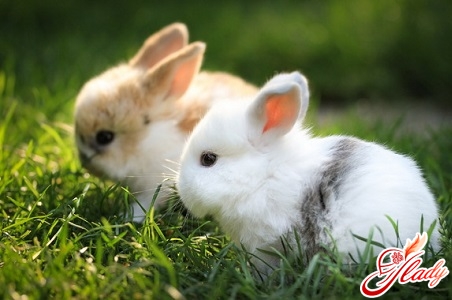
Diseases of rabbits
Rabbits, like all living things, are prone tovarious diseases. Moreover, the pet can become infected with an infectious disease. Do not worry, for a person these infections are not dangerous, but for other animals in the house - yes. The non-contagious are:
- Gastrointestinal diseases;
- Solar and thermal shocks;
- Traumatic injuries;
- Diseases of the respiratory system;
- Pododermatitis;
- Conjunctivitis;
- Rickets;
- Frostbite.
Infectious Diseases:
- Infectious rhinitis;
- Dermatophytosis or microsporia;
- Viral hemorrhagic disease;
- Infectious stomatitis;
- Myxomatosis;
- Pasteurellosis;
- Staphylococcosis;
- Listeriosis.
We will not describe these diseases, since the diagnosis is made by a veterinarian. But what you need to know in order to monitor the health of the pet:
- The body temperature of the rabbit should be 38.5-39.7 Celsius.
- The pulse should be 120-140 beats per minute.
- The frequency of breathing is 30-50 movements per minute.
- The urine should not exceed 0.2 liters per day.
- Blood pressure is normal - 90-10 mm mercurypost. It is measured in the femoral artery. If one of the indicators is different - contact the veterinarian immediately!
So, to sum up all of the above, we wantto remind once again that rabbits are not fluffy toys, but living beings. If you decide to purchase a dwarf rabbit, then be responsible for it. We advise you to read:




